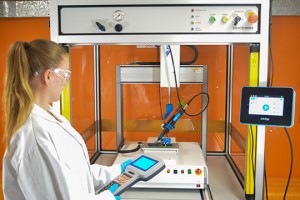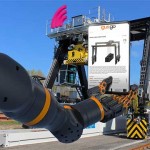Dispensing robots: what’s the risk?
 Peter Swanson, managing director of adhesives and dispensing equipment specialist Intertronics, assesses the risk versus reward of investing in dispensing automation.
Peter Swanson, managing director of adhesives and dispensing equipment specialist Intertronics, assesses the risk versus reward of investing in dispensing automation.
The application of adhesives, potting compounds, encapsulants or other liquids, fluids or pastes, is something that can often be readily automated with a dispensing robot. However, manufacturers that are still performing these processes manually may be concerned about the potential risks of transforming their processes with automation. On the other hand, the potential rewards are great — including improved consistency, speed, and accuracy that lead to gains in productivity.
According to the International Federation of Robotics 2021 World Robot Report, the UK ranks below the global average of 126 robots per 10,000 employees, placing it 24th in the world in terms of robot density. Europe’s most automated country, Germany, has 371 robots per 10,000 employees, while the UK has just 101 per 10,000 employees. This trend, of increased robot use in mainland Europe contrasted with a downward trend in the UK, looks set to continue. In 2021, robot installations across Europe were up 24% to 4,302 units – a new peak – but down by 7% to 2,054 units in the UK.
Britain’s lack of investment in robots has its roots in the financial crisis of 2008. This is due, in part, to the culture of British industry. If you attend a manufacturing facility in Germany, for instance, the team might proudly point out their newest technology investments. In the UK, the plant manager is more likely to point to a trusted, reliable machine that has been in use for more than 20 years.
Britain has fallen behind the global average investment in robots. As the rest of Europe invests heavily in automation to drive productivity, the UK’s ability to remain competitive will be dependent on breaking the barriers to automation.
Automation: risk or reward?
One of the historic barriers to automation is the perceived risk of investing in new equipment. After all, if a manual process is working well then why upset the applecart? Nevertheless, recent events like Covid, the war in Ukraine, and Brexit have impacted how we do business, and how industry perceives risk.
Supply chain challenges are making it more difficult to source components, and the risks associated with long global supply chains mean that many manufacturers are reshoring their manufacturing operations. Businesses are also increasing their local supplier base. According to a survey by Make UK, three quarters of companies have increased the number of British suppliers they are using.
The success of these reshoring programmes depends on the availability of labour and, at present, the UK is facing a high number of job vacancies. If manufacturers are unable to recruit the people they need to reshore manual processes, then alternative methods of production become more attractive.
Following the events of the last few years, manufacturers are now more likely to see the opportunities of robots, rather than the risks. As Henry Ford once said: “If you need a machine and don’t buy it, you pay for it without getting it.”
With these factors in mind, the application of adhesives and other materials is a prime candidate for automation. A dispensing robot can apply materials with positional accuracy and precise quantities, and repeat that all day long. The output is often faster than a manual process and, sometimes, robots can achieve results that are not possible for a human. For example, applying an even bead of gasketing around a complex profile is not manually feasible.
For manufacturers looking to invest in dispensing automation, there are four main components to the system. They are, first, the robot used to position and actuate the dispenser and, second, the dispenser (valve, pump, syringe or cartridge as well as the required controller and material reservoir) that is chosen to distribute the material. The third component is the tooling used to hold the parts in place and, fourth, the enclosure – an important consideration for health and safety.
The specification and choice of the dispensing methodology (valve, pump, syringe, cartridge, etc) is quite complex and material dependent. By working with a reliable supplier that understands the intricacies of both the chemistry and the dispensing technology, manufacturers are more likely to invest in an optimal combination of technologies for their application – and get better results. Your supplier should also be able to integrate the dispenser with the robot and configure and customise the system with holding tools and fixtures, benches, and safety enclosures. The last piece of the puzzle is installation and training, to ensure that you are up and running right away, and that your team understands how to operate the equipment to get the best from it.
Reducing the risk
To help de-risk the investment further, check that the supplier has been validated by a third party. Do they have a number of case studies that show successful robot installations? At Intertronics, we also offer customers the opportunity to visit our Technology Centre in Kidlington, Oxfordshire, where we can support with trials and tests to establish how the equipment will perform in your application.
In many cases, the upfront cost of dispensing robots is not as high as some manufacturers think; at Intertronics, we often see our customers achieve a payback period of six months-to-a year, although it may take up-to two years in some applications.
With the UK lagging in its robot uptake, it’s time we focus on the rewards of robots: improved productivity, efficiency, output, quality, and flexibility. In applications like dispensing, which lend themselves so well to automation, manufacturers have a lot to gain and very little to lose.
Visit the Intertronics website for more information
See all stories for Intertronics















